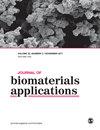Meniscal repair with additive manufacture of bioresorbable polymer: From physicochemical characterization to implantation of 3D printed poly (L-co-D, L lactide-co-trimethylene carbonate) with autologous stem cells in rabbits
IF 2.3
4区 医学
Q3 ENGINEERING, BIOMEDICAL
引用次数: 0
Abstract
Three-dimensional (3D) structures are actually the state-of-the-art technique to create porous scaffolds for tissue engineering. Since regeneration in cartilage tissue is limited due to intrinsic cellular properties this study aims to develop and characterize three-dimensional porous scaffolds of poly (L-co-D, L lactide-co-trimethylene carbonate), PLDLA-TMC, obtained by 3D fiber deposition technique. The PLDLA-TMC terpolymer scaffolds (70:30), were obtained and characterized by scanning electron microscopy, gel permeation chromatography, differential scanning calorimetry, thermal gravimetric analysis, compression mechanical testing and study on in vitro degradation, which showed its amorphous characteristics, cylindrical geometry, and interconnected pores. The in vitro degradation study showed significant loss of mechanical properties compatible with a decrease in molar mass, accompanied by changes in morphology. The histocompatibility association of mesenchymal stem cells from rabbit’s bone marrow, and PLDLA-TMC scaffolds, were evaluated in the meniscus regeneration, proving the potential of cell culture at in vivo tissue regeneration. Nine New Zealand rabbits underwent total medial meniscectomy, yielding three treatments: implantation of the seeded PLDLA-TMC scaffold, implantation of the unseeded PLDLA-TMC and negative control (defect without any implant). After 24 weeks, the results revealed the presence of fibrocartilage in the animals treated with polymer. However, the regeneration obtained with the seeded PLDLA-TMC scaffolds with mesenchymal stem cells had become intimal to mature fibrocartilaginous tissue of normal meniscus both macroscopically and histologically. This study demonstrated the effectiveness of the PLDLA-TMC scaffold in meniscus regeneration and the potential of mesenchymal stem cells in tissue engineering, without the use of growth factors. It is concluded that bioresorbable polymers represent a promising alternative for tissue regeneration.用生物可吸收聚合物的添加剂制造技术修复半月板:从物理化学表征到在兔子体内植入带有自体干细胞的 3D 打印聚(L-co-D, L lactide-co-trimethylene carbonate)材料
三维(3D)结构实际上是为组织工程创建多孔支架的最先进技术。由于软骨组织的再生受到细胞固有特性的限制,本研究旨在开发和表征通过三维纤维沉积技术获得的聚(L-co-D, L lactide-co-trimethylene carbonate)PLDLA-TMC三维多孔支架。通过扫描电子显微镜、凝胶渗透色谱法、差示扫描量热法、热重分析、压缩机械测试和体外降解研究,获得了 PLDLA-TMC 三元共聚物支架(70:30),并对其进行了表征。体外降解研究表明,随着摩尔质量的降低,机械性能显著下降,同时形态也发生了变化。在半月板再生中评估了兔骨髓间充质干细胞与 PLDLA-TMC 支架的组织相容性,证明了细胞培养在体内组织再生中的潜力。九只新西兰兔接受了内侧半月板全切除术,并进行了三种处理:植入播种的 PLDLA-TMC 支架、植入未播种的 PLDLA-TMC 支架和阴性对照(缺损处未植入任何支架)。24 周后,结果显示使用聚合物处理的动物出现了纤维软骨。然而,在播种了间充质干细胞的 PLDLA-TMC 支架上获得的再生,无论从宏观还是组织学角度来看,都已成为正常半月板的成熟纤维软骨组织。这项研究证明了 PLDLA-TMC 支架在半月板再生中的有效性,以及间充质干细胞在组织工程中的潜力,而无需使用生长因子。结论是,生物可吸收聚合物是组织再生的一种有前途的替代材料。
本文章由计算机程序翻译,如有差异,请以英文原文为准。
求助全文
约1分钟内获得全文
求助全文
来源期刊

Journal of Biomaterials Applications
工程技术-材料科学:生物材料
CiteScore
5.10
自引率
3.40%
发文量
144
审稿时长
1.5 months
期刊介绍:
The Journal of Biomaterials Applications is a fully peer reviewed international journal that publishes original research and review articles that emphasize the development, manufacture and clinical applications of biomaterials.
Peer-reviewed articles by biomedical specialists from around the world cover:
New developments in biomaterials, R&D, properties and performance, evaluation and applications
Applications in biomedical materials and devices - from sutures and wound dressings to biosensors and cardiovascular devices
Current findings in biological compatibility/incompatibility of biomaterials
The Journal of Biomaterials Applications publishes original articles that emphasize the development, manufacture and clinical applications of biomaterials. Biomaterials continue to be one of the most rapidly growing areas of research in plastics today and certainly one of the biggest technical challenges, since biomaterial performance is dependent on polymer compatibility with the aggressive biological environment. The Journal cuts across disciplines and focuses on medical research and topics that present the broadest view of practical applications of biomaterials in actual clinical use.
The Journal of Biomaterial Applications is devoted to new and emerging biomaterials technologies, particularly focusing on the many applications which are under development at industrial biomedical and polymer research facilities, as well as the ongoing activities in academic, medical and applied clinical uses of devices.
 求助内容:
求助内容: 应助结果提醒方式:
应助结果提醒方式:


